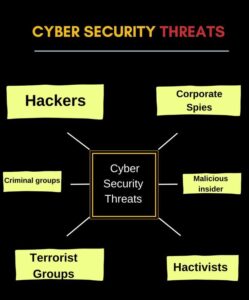A Citizen Manual on Cybersecurity provides essential guidelines and practices for individuals to stay safe online. It can include the following key sections:
1. Understanding Cybersecurity
•Cybersecurity refers to protecting digital devices, networks, and data from unauthorized access or attacks. It’s essential for safeguarding personal information, finances, and privacy.

2. Common Cyber Threats
•Phishing: Fraudulent emails or messages that trick you into revealing sensitive information.
•Malware: Malicious software like viruses, ransomware, or spyware that harms your device.
•Identity Theft: Criminals stealing personal data to impersonate you or commit fraud.
•Hacking: Unauthorized access to personal or financial information.
3. Best Practices for Cybersecurity
•Strong Passwords: Use complex and unique passwords for each account; avoid using common words or easily guessed information like birthdays.
•Two-Factor Authentication (2FA): Enable 2FA for online accounts to add a second layer of security.
•Antivirus Software: Install reputable antivirus programs and update them regularly to protect against malware.
•Regular Software Updates: Ensure your operating system, apps, and browsers are always
up to date to avoid vulnerabilities.
•Data Backup: Regularly back up important files and data, preferably on an external device
or secure cloud storage.
4. Safe Internet and Email Use
•Identify Phishing Attempts: Be cautious of unsolicited emails or messages asking for personal information. Verify the sender before clicking on links or downloading attachments.
•Avoid Public Wi-Fi for Sensitive Transactions: Public Wi-Fi is often unsecured; use a Virtual Private Network (VPN) if you must access sensitive information.
•Social Media Privacy: Limit the amount of personal information you share on social platforms. Adjust your privacy settings to control who can see your content.
5. Protecting Financial Information
•Monitor Bank Accounts: Regularly check your bank statements for unusual activity.
•Use Secure Payment Methods: Prefer online payment methods with added security, like credit cards or trusted payment platforms.
•Beware of Scams: Be alert to online offers that seem too good to be true, and always verify the legitimacy of online sellers.
6. Children’s Cyber Safety
•Supervise Online Activities: Ensure children use child-friendly platforms and are aware of online risks.
•Teach Safe Internet Use: Educate children about not sharing personal details and recognizing suspicious online behavior.
•Parental Controls: Use parental controls to monitor and limit children’s internet use where necessary.
7. Responding to Cyber Incidents
•Report Cybercrimes: Contact local authorities or cybersecurity agencies if you experience cybercrime.
•Recovering from a Data Breach: If your data is compromised, reset passwords immediately and inform your bank or financial institution.
•Credit Monitoring: If your identity is stolen, consider enrolling in a credit monitoring service to prevent further fraud.
8. Staying Informed
•Stay updated on the latest cybersecurity trends and threats by following credible sources and government guidelines.
By following these practices, citizens can better protect their personal information, devices, and digital identities from cyber threats.
 2. Common Cyber Threats
2. Common Cyber Threats 2. Common Cyber Threats
2. Common Cyber Threats